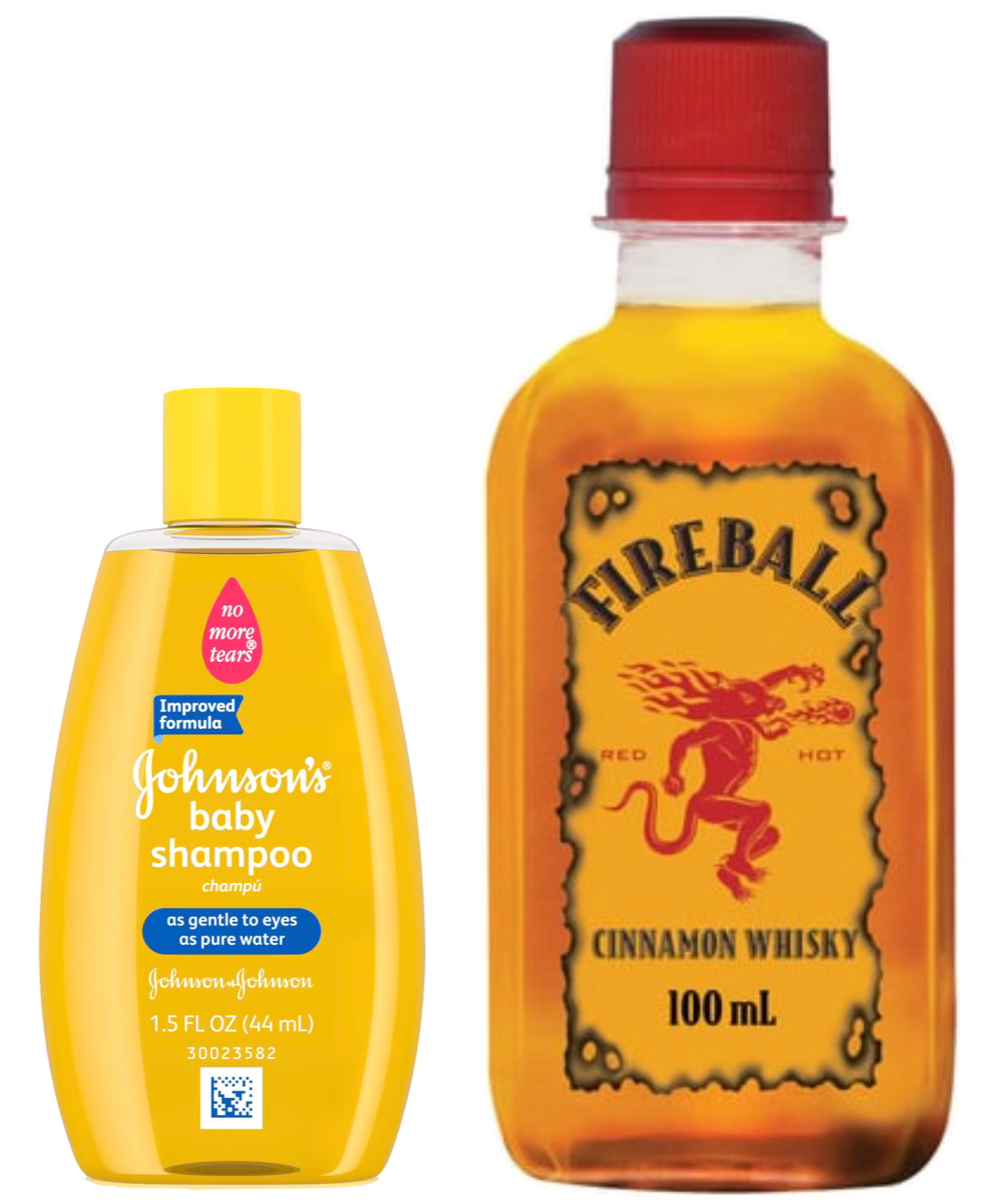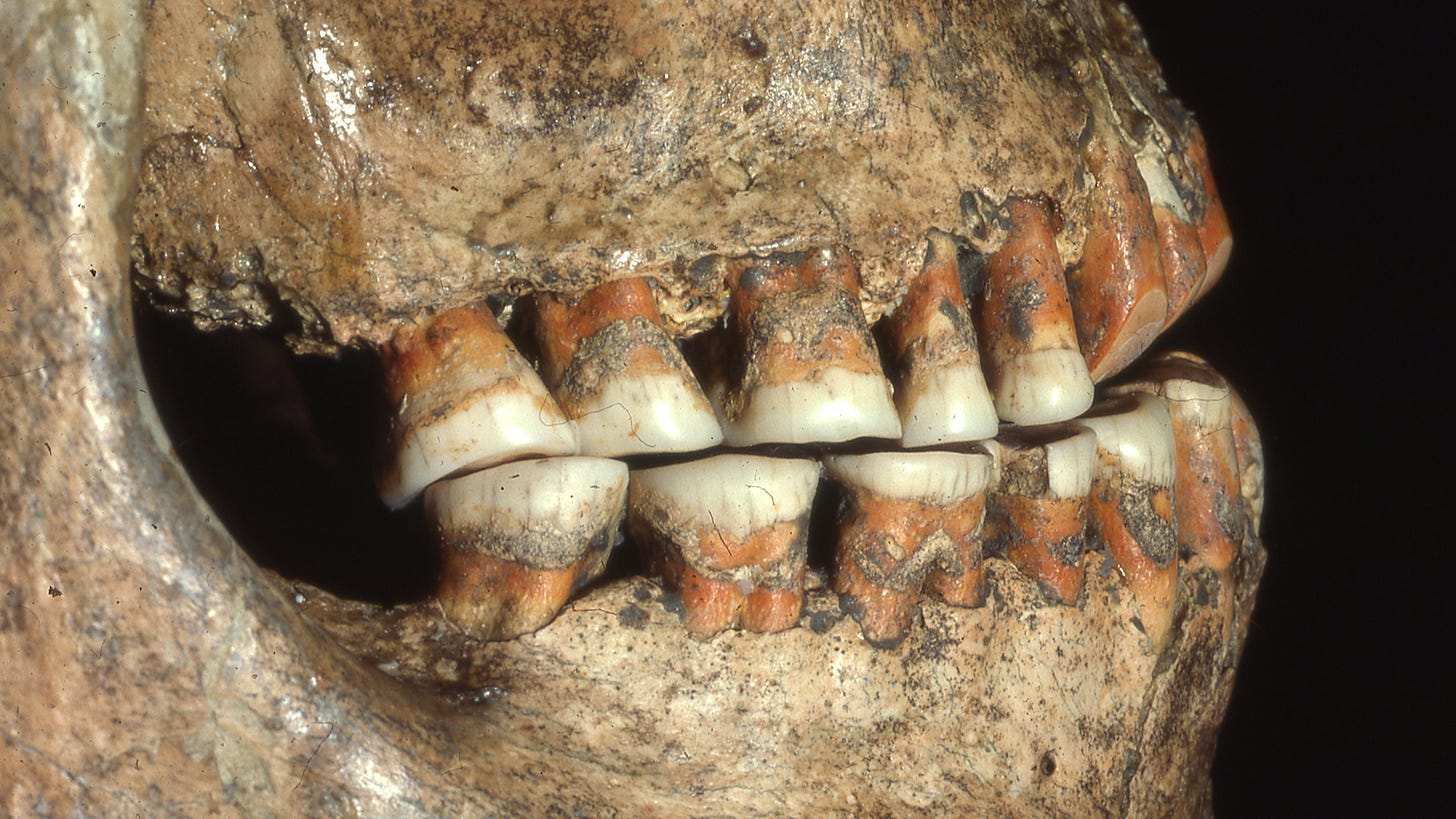I have known one patient in my career who, at 104 years old, had never had a single dental procedure beyond regular cleanings—including braces! I have to assume genetics played the primary role. She was remarkably healthy, walking in under her own power without a cane, taking NO medications, and her mind was quick and lucid. I have my reasons for why I believe she experienced general longevity and mental acuity. To this day, I still cannot account for her apparently perfect teeth.
A Redditor asked the question recently: “What is, in your opinion, the biggest flaw in the human body?”1 A repeated response, and one which earned the most upvotes, was “the teeth.” The fact that we get only two sets and lose the first set by puberty; that teeth require daily, dedicated effort to maintain; that teeth and gums form a fragile, direct route of slow infection of the body. A more frequent response is the existence and process of female menstruation. Their arguments are interesting and involve a topic for which I am no expert. But of teeth, I have something to say with an education, licensure, and life experience that shares a zip code with experts.
The very question about flaws presupposes that there were options for a design and some seemingly more favorable alternative may have been had. If there were a designer, these questions assume that the asker’s intellect and design capacity exceed that of a greater mind capable of wielding the power of creation ex nihilo. A conceit hidden in the question may reveal that we humans, despite our current milieu and socio-religious programming can’t help but believe that our intelligence rivals that of the gods of our fathers. Since we are aware of our impotence, that our potence will never approach the omni state, we do what humans do best and lodge a complaint. We look at a tooth and think it should always look and behave as if it were left under museum glass and not needed every moment of every day to be used!
What constitutes the negatives of the poorly-designed oral cavity? Only two sets of teeth, the first of which is lost by puberty. Sub optimal maintenance of the teeth is likely to lead to the inability to chew food and compromise nutrition intake? The teeth are a veritable bacterial spa for which our diets and the relative humidity spoil the very parasites that indifferently seek to cause pain, promote infection, and contribute to heart disease and dementia risk? That the second set of teeth wear away when they don’t decay and often fracture. That our jaws, the only humans joints capable of movement in three dimensions, deteriorate and cause chronic pain from the very system we need to eat and communicate.
Why did Noah and Methuselah, 900 year-olds, never mention their teeth? They hadn’t the hygienic practices we do? Their diet was likely lacking in the refined sugars we glut upon now, but it was far more coarse. The simple explanation is that their stories are mythological. As is typical of myths, their characters rarely deal with the everyday problems of everyday life for everyday people. When our human nature leads us to list dentists/dental care as a fear often more daunting than public speaking and death, it seems strange that humans who lived for nine centuries never allude to gumming their food after losing their second, very delicate set of baby teeth.
However, if we accept that our species evolved by natural selection rather than assume that it was designed by an omni-benevolent, omni-intelligent, omni-potent God, something like our teeth become a useful insight into our origins rather than a source for crude solipsism.
Would you think that organs like teeth are somehow more flawed than skin? Every year in the U.S. as many as 350,000 of people die from wounds to the skin that develop septic infections. In contrast only 5-10 people will die from tooth infections gone septic. (This number may have been as high as 40% prior to the discovery of Penicillin during WWI.) Certainly, far more than 10 dangerous infections occur each year. I’ve personally referred five individuals in my career for emergency extraction. In two of those cases, the oral surgeon called me personally to inform me that the patient was an hour from an ER visit. In one case, the patient still ended up in the ER after extraction when multiple organ failure developed the next day as he recovered—the infection was simply already too advanced. The patient survived, but that outcome was in question for some time.
Skepticism of dental care root canal treatments ebbs and flows, with anecdotal claims of the slow poison in your body, going side by side with assertions that the teeth are a design flaw. Root canals prevent and maintain teeth that might otherwise result in similar outcomes to those patient experiences I was a part of. Consider avoiding dental care for fear or lack of money only to end up in the chair with agonizing pain, a stiff neck, fever, and a jaw that looks like a golf ball has grown beside it. A root canal may have been possible at an earlier time, preventing the acute emergency. Identifying swelling below the jaw line accompanied by a sense that swallowing is difficult and breathing constricted, your dentist tells you this is an emergency, go to the oral surgeon. NOW. The oral surgeon can’t merely remove the tooth at this point. Even though it has become the source of the infection, the disease has spread down your neck, compressing the esophagus and wind pipe. In the case described above, the oral surgeon called me to tell me that the infection had not only travelled down the neck toward the heart, but it had also crossed the midline of the neck. (Infections don’t cross midlines of the face easily.) He then tells you that after removing the tooth, he succeeded in draining, from each side, more pus than could be legally carried in an airplane carry-on bag.2 From. Each. Side. The patient’s obesity was enough to completely obscure the swelling. As bad as it was, she was not the patient that required admission to the ER. That patient was a stay-at-home father whose young children nearly lost him due to the expense of dental care they couldn’t afford until they had to pay for it or die.

Nevertheless, despite my sensational story, infections of the teeth pose less a threat to your well-being and survival than your skin—by five orders of magnitude! In our modern world, you are 35,000 times more likely to die from a cut of the skin. This is not considered a design flaw by Redditors because, in my opinion, the skin takes very little maintenance compared to the teeth. People hate brushing their teeth and flossing. Is two times a day enough? For most people under 60, probably. After 60, they require more effort for most people.
Here’s the kicker: evolution of our teeth has not caught up with our ability to extend life expectancy. Sure, you lose your first set of teeth at 12 and only one other set succeeds them. Consider that from the first fossil evidence of our species approximately 100,000 to 200,000 years ago, globally speaking, a baby born could only expect to live to twenty-five years old until the late 18th century! Up to 1800 C.E., about 50% of babies would not live to puberty. That is to say, our teeth, historically, were needed only until we died at the old age 25. The fact that with annoying oral hygiene and regular dental care, most people in America today can expect to keep most of their teeth for their entire life is remarkable.
The fever to ban fluoride only works against our design flaw. Paleo-mindedness may prove to be right with time, but I remain skeptical. I don’t want to return to a time when our ancestors lived with rotting teeth and lack of antibiotics until they died in their mid-twenties. Our American diet is bad for both our teeth and our hearts. Much of what we consume is for pleasure both esthetically (artificial flavors and effervescence) and with regard to flavor (sweeteners, effervescence, fat, salt). We have acquired the knowledge and skill to repair many teeth that are far outliving their evolutionary life-span and design flaws. Teeth, annoying as they are, offer support to the theory that our species evolved.
Primitive people ate diets so coarse we couldn’t imagine it. The teeth of a tribal elder in their early thirties would be flat if present. Often decayed, fractured, and rife with periodontal disease factors. The baby teeth are lost and wouldn’t it be great if we got more? Well, the small teeth’s ability to grant us the capability to chew while our jaws grow and then relinquish their position to a larger, more robust successor is a wondrous thing. Adult teeth develop AS we grow and erupt in a sequence that takes advantage of that growth. Third molars are colloquially referred to as wisdom teeth for a reason. They typically erupt at 18 years old when a primitive human was already an old, wisened man or woman. It granted them fresh masticatory ability for their final five to seven years of life in the event the teeth ahead of them had already outlived their life span. Some researchers are trying to understand if our species is developing fewer third molars than our ancestors since, evolutionarily, we don’t require them any longer.
Conveniently, our design flaw also has the ability to continue to erupt throughout life. So, as your teeth wear on each other, they continue to erupt to meet their opposing tooth, permitting lifelong, continued function. This wear also enables the back teeth to accommodate the changes in the joints as we age. Except, this is not something our ancestors would have needed. Unlike them, we do live long enough to experience osteoporosis and the simple changes to bone from aging and extended function. As soon as adults reach their full growth potential in their early twenties, everything begins a slow demise. The portions of the jaw bone within the joint—the condyle—will lose height for most people simply with age. Our teeth can wear to accommodate this change.
Tooth wear also reveals another adaptation in which the pulp of the tooth—where blood and nerves run—can lay down layers of new dentin to insulate against decay and wear. Our ancestors needed the benefits of this phenomenon at a much younger age than modern humans, but we do see it as a rule in nearly every adult patient with occasion for a root canal or deep restoration. None of it is perfect and, if designed, may be subject to scrutiny but from which human that would dare critique it? For me, it supports the wonder of evolution by natural selection. Not only that, but it gives me a little more than hope that experts who have taken a design flaw like teeth and managed to figure out a way in which most people, even with our poor diet, can keep their 25-year teeth for a century in good health. I’m a part of doing it every day.

https://www.reddit.com/r/AskReddit/comments/1l1fmxz/what_is_in_your_opinion_the_biggest_flaw_of_the/
Not for the faint of heart…if you want to see this surgery performed, here is a YouTube link.



